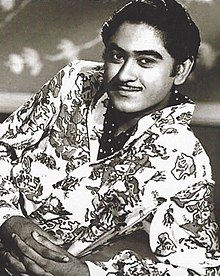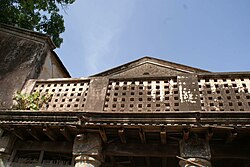Khandwa district
Khandwa district | |
|---|---|
Clockwise from top-left: Ghats of Mandhata, Mamleshwar temple, Omkareshwar Dam, Gauri Kunj, Khandwa railway station | |
 Location of Khandwa district in Madhya Pradesh | |
| Country | |
| State | Madhya Pradesh |
| Division | Indore |
| Headquarters | Khandwa |
| Tehsils | Khandwa Pandhana |
| Government | |
| • Lok Sabha constituencies | Khandwa |
| • Vidhan Sabha constituencies | Mandhata (175) Harsud (176) Khandwa (177) Pandhana (178) |
| Area | |
| • Total | 6,206 km2 (2,396 sq mi) |
| Population (2011) | |
| • Total | 1,310,061 |
| • Density | 210/km2 (550/sq mi) |
| Demographics | |
| • Literacy | 67.53 per cent |
| • Sex ratio | 944 |
| Time zone | UTC+05:30 (IST) |
| Major highways | Khandwa-Indore State Highway Khandwa-Mundi-Ashta State Highway Khandwa-Amrawati Road |
| Website | khandwa |
Khandwa district, formerly known as the East Nimar district, is a district of the Madhya Pradesh state in central India. The city of Khandwa is the administrative headquarters of the district. Other notable towns in the district include Mundi, Harsud, Punasa, Pandhana and Omkareshwar.
Geography
[edit]The district has an area of 6,206 km2 (2,396 sq mi), and a population 1,310,061 (2011 census). Khandwa District lies in the Nimar region, which includes the lower valley of the Narmada River, Kherkhali River, Choti Tawa River, Shiva River. The Narmada forms part of the northern boundary of the district, and the Satpura Range form the southern boundary of the district. Burhanpur District, to the south, lies in the basin of the Tapti River. The pass through the Satpuras connecting Khandwa and Burhanpur is one of the main routes connecting northern and southern India, and the fortress of Asirgarh, which commands the pass, is known as the "Key to the Deccan". Betul and Harda districts lie to the east, Dewas District to the north, and Khargone District to the west.
History
[edit]Khandwa district was surrendered by the Marathas to the British Raj in 1818, and later became part of the Central Provinces and Berar. The area to the west, which forms the present Khargone district, was part of the princely state of Indore. After India's independence in 1947, the Central Provinces and Berar became the new Indian state of Madhya Pradesh.
The Khandwa district was known as "Nimar District" before 1956, when the state of Madhya Bharat to the west was merged with the state of Madhya Pradesh. Later it came to be called "East Nimar district", and a separate "West Nimar district" with headquarters at Khargone was established. The East Nimar district was part of the Nerbudda (Narmada) Division of the Central Provinces and Berar, which became the state of Madhya Bharat (later Madhya Pradesh) after India's independence in 1947.[1] Khandwa was known as East Nimar until recently. Burhanpur District was separated from Khandwa District on 15 August 2003. Khandwa District is part of Indore Division.
Economy
[edit]In 2006 the Ministry of Panchayati Raj named Khandwa one of the country's 250 most backward districts (out of a total of 640).[2] It is one of the 24 districts in Madhya Pradesh currently receiving funds from the Backward Regions Grant Fund Programme (BRGF).[2]
Agriculture and Industries
[edit]Khandwa's economy is dependent on agriculture, Due to its location in the Narmada basin, the land here is fertile, with several small scale industries in the cities of Khandwa. Some edible oil mill loceted in Khandwa. The major cash crops of the Khandwa district are Onion, soybean, and Chana.[3]
Sant Singaji Thermal Power Plant and Dada Dhuniwale Thermal Power Plant are located in Khandwa District. 50 Megawatt Solar Power Plant also Situated near Khandwa.[4]
Demographics
[edit]| Year | Pop. | ±% p.a. |
|---|---|---|
| 1901 | 210,188 | — |
| 1911 | 250,875 | +1.79% |
| 1921 | 254,443 | +0.14% |
| 1931 | 299,822 | +1.65% |
| 1941 | 329,540 | +0.95% |
| 1951 | 346,916 | +0.52% |
| 1961 | 446,906 | +2.57% |
| 1971 | 568,143 | +2.43% |
| 1981 | 729,781 | +2.54% |
| 1991 | 898,596 | +2.10% |
| 2001 | 1,078,251 | +1.84% |
| 2011 | 1,310,061 | +1.97% |
| source:[5] | ||
According to the 2011 census Khandwa District has a population of 1,310,061,[6] This gives it a ranking of 374th in India (out of a total of 640).[6] The district has a population density of 178 inhabitants per square kilometre (460/sq mi).[6] Its population growth rate over the decade 2001–2011 was 21.44%.[6] East Nimar has a sex ratio of 944 females for every 1,000 males,[6] and a literacy rate of 67.53%. 19.80% of the population lives in urban areas. Scheduled Castes and Scheduled Tribes make up 11.95% and 35.05% of the population respectively.[6]
Languages
[edit]At the time of the 2011 Census of India, 40.59% of the population in the district spoke Nimadi, 33.84% Hindi, 9.71% Korku, 3.20% Urdu, 2.94% Bhili, 2.06% Bareli, 1.67% Banjari, 1.24% Gondi, 1.05% Marathi and 0.97% Bhilali as their first language.[8]
Languages spoken include Nimadi, a Bhil language with approximately 64 000 speakers, written in the Devanagari script.[9]
Cities of Khandwa
[edit]Major cities of Khandawa include-
Notable people
[edit]
- Ashok Kumar
- Kishore Kumar, singer and actor
- Anoop Kumar
- Bhagwantrao Mandloi, former Chief Minister of Madhya Pradesh
- Pt. Makhanlal Chaturvedi, Hindi poet & freedom fighter
- Shaan (singer)
- Saroo Brierley was born in Khandwa and lived there until about the age of five years when he was lost and adopted by a family in Australia[10]
Tourist places
[edit]- Omkareshwar
- Mandhata
- Scenic Sailani Island
- Khandwa Town
- Indirasagar Dam
- Sant Singaji Dham
- Shree Dadaji Dhuniwale Dham Dada Darbar (Khandwa)
- Jain Temple Sidhwarkut
- Khandwa Fort
- Hanumantiya Island
See also
[edit]References
[edit]- ^ Hunter, William Wilson, Sir, et al. (1908). Imperial Gazetteer of India, Volume 6. 1908-1931; Clarendon Press, Oxford
- ^ a b Ministry of Panchayati Raj (8 September 2009). "A Note on the Backward Regions Grant Fund Programme" (PDF). National Institute of Rural Development. Archived from the original (PDF) on 5 April 2012. Retrieved 27 September 2011.
- ^ Crops of Khandwa District
- ^ http://www.mppgenco.nic.in/sstps-khandwa.html
- ^ "Table A-02 Decadal Variation in Population Since 1901: Madhya Pradesh" (PDF). census.gov.in. Registrar General and Census Commissioner of India.
- ^ a b c d e f "District Census Handbook: Khandwa" (PDF). Census of India. Registrar General and Census Commissioner of India. 2011.
- ^ "Table C-01 Population By Religion: Madhya Pradesh". census.gov.in. Registrar General and Census Commissioner of India.
- ^ a b "Table C-16 Population by Mother Tongue: Madhya Pradesh". censusindia.gov.in. Registrar General and Census Commissioner of India.
- ^ M. Paul Lewis, ed. (2009). "Bareli, Rathwi: A language of India". Ethnologue: Languages of the World (16th ed.). Dallas, Texas: SIL International. Retrieved 28 September 2011.[permanent dead link]
- ^ Brierley, Saroo (2013). A Long Way Home. Viking, Australia ISBN 9780670077045





